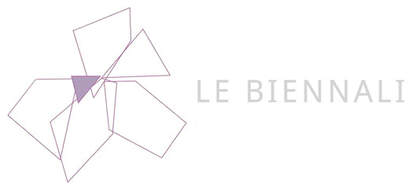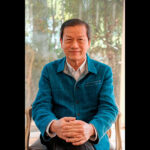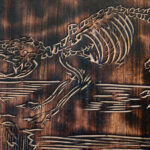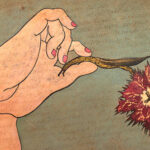Nurture Gaia
Roma – 4 Marzo 2025 by Vittoria Biasi
Translation by C.E. Glatz
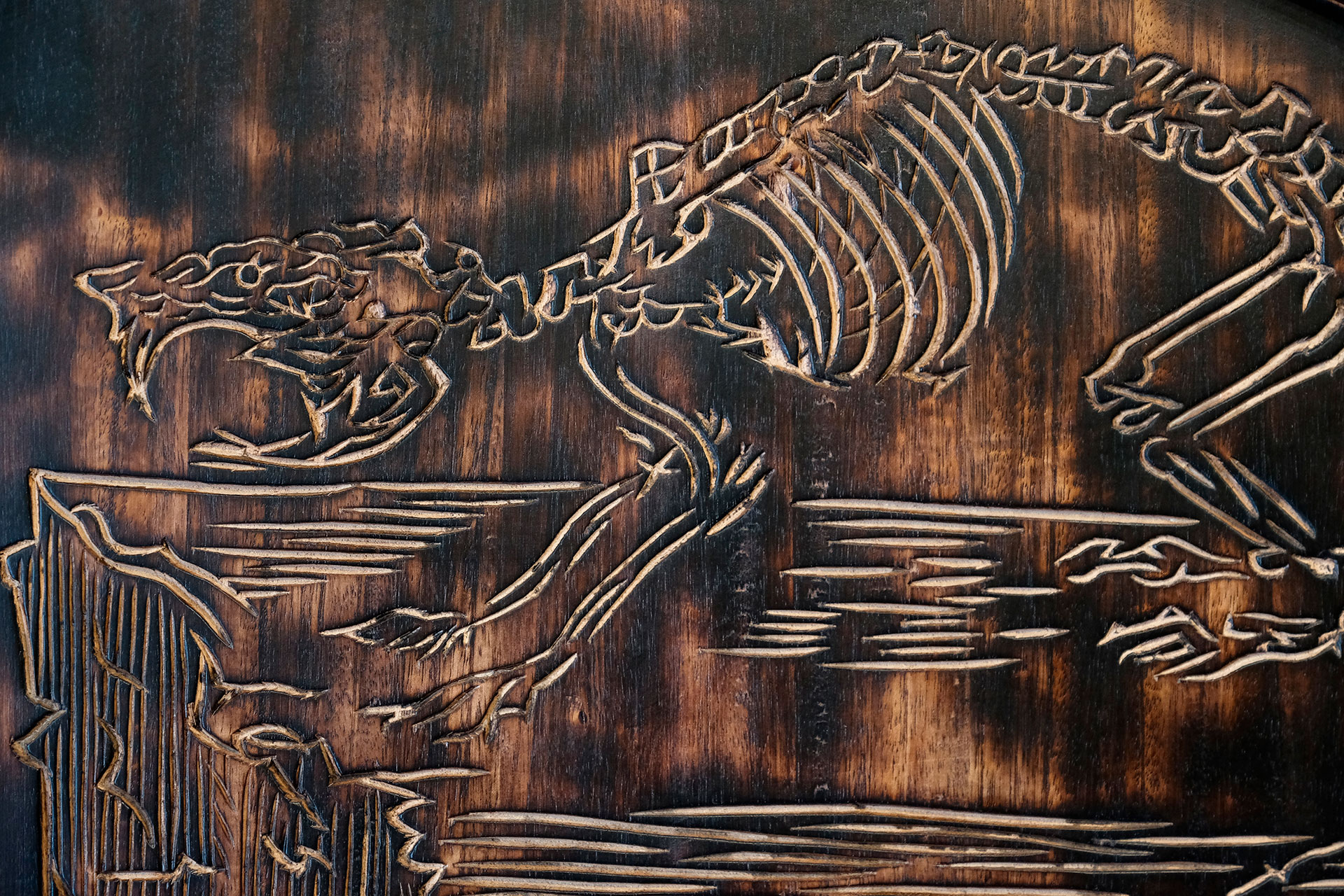
Il direttore Apinan Poshyananda è il padre della biennale tailandese e nella IV edizione dal titolo Nurture Gaia ha invitato artisti provenienti da Europa, Asia, Nord e Sud America, Africa e Oceania per riflettere sulla relazione tra uomo e natura1. Le precedenti Bangkok Art Biennales, a cura di Apinan Poshyananda: Beyond Bliss, 2018; Escape Routes, 2020; e CHAOS: CALM, 2022, hanno strutturato una visione, un metodo di costruzione e riconoscibilità di un prezioso pensiero filosofico orientale. Le opere esposte sono capitoli della stessa storia: quella dell’uomo e dell’artista che, sollecitati dalla bellezza della natura, del cielo, delle acque, del mondo intraprendono un percorso cercando l’eccezionalità del fare e del pensare sull’uomo e per l’uomo2.
Gaia è la Divinità della Terra, onorata nel mito greco e nella storia di tutti popoli con differenti modalità di culto, ma con un comune, religioso rapporto. In rispetto di questo, forse, l’esposizione della Bangkok Art Biennale è stata distribuita tra musei, centri di cultura e spazi dei templi, che ampliano la percezione della ricerca artistica.
Il Wat Arun Ratchawararam, conosciuto come il Tempio dell’Aurora, si affaccia sul fiume Chao Phraya. La torre centrale (prang), alta 86 metri, poggia su due tronchi sovrapposti rivestiti con sculture di demoni della mitologia buddhista e induista. Questi sembrano reggere la parte superiore della torre ricoperta di fiori di cui ogni petalo, in porcellana cinese, è stato lavorato e applicato manualmente. In uno spazio esterno al complesso di torri, in prossimità dell’uscita, vi è l’installazione di color bianco fluorescente, The Horde, dell’artista tailandese Hariton Akarapat. La luminosa monocromia dei suoi elementi si inserisce nella sacralità del luogo. L’installazione, composta da sculture in fibra di vetro di dimensioni tra i due e i cinque metri di altezza, appare come una postazione di difesa a sostegno dei demoni guerrieri che presidiano punti strategici dell’area.
Le figure astratte di tronchi d’alberi levigati e con le estremità rotondeggianti come una testa d’uomo sembrano portatori di un’anima e di una religiosità che ha attraversato tempi e forme. Dai lati fuoriescono rami protesi forse a tendere una mano. Il colore fluorescente dà leggerezza alle opere sospingendole verso un mondo metafisico.
Le opere di Yanawit Kunchaethong, nel Wat Pho, nascono dal pensiero filosofico di una comune energia che collega il mondo. Studioso degli alberi, delle piante, dei fiori ne ha percepito l’anima non come risposta a una forma di immaginazione trascendentale ma come percezione analizzata di un legame profondo e cosmico racchiusa nella materia. L’artista ha curato il rapporto con le piante a livello conservativo delle specie e delle radici e lo ha tradotto in linguaggio artistico. Ha trasformato le parti morte o essiccate delle piante in polveri o pigmenti per creare colori, stampe organiche e tutto ciò che può far continuare a vivere quell’insieme particolare di materia e spirito sotto altra forma. Artisti come Yanawit Kunchaethong e filosofi come Emanuele Coccia si dedicano allo studio della natura che considerano le nostre ultime divinità, modellatrici della vita sul nostro pianeta3. Nakrob Moonmanat affronta i temi delle crisi ambientali dell’Antropocene installando sculture di pesci o di antichi manufatti ispirati dalle documentazioni di viaggiatori del Siam che si sono spostati verso altre culture e altre terre durante il regno di Rama III.
Art director, Apinan Poshyananda, is the father of the Thai biennale, and for the fourth edition titled, Nurture Gaia, he invited artists from Europe, Asia, North and South America, Africa and Oceania to reflect on the relationship between human beings and nature1. The previous Bangkok Art Biennales curated by Apinan Poshyananda: Beyond Bliss, 2018; Escape Routes, 2020; and CHAOS: CALM, 2022, gave structure to a vision, a method of constructing and recognizing a valuable Eastern philosophical notion. The exhibited works are chapters of the same story: that of human beings and the artist who, inspired by the beauty of nature, the sky, the water and the world, embark on a path seeking the exceptionality of creating and thinking about humanity, for humanity2.
Gaia is the goddess of the Earth, honored in Greek mythology and in the history of all peoples with different forms of worship, but with a common, religious relationship. It is perhaps in regard to this that the Bangkok Art Biennale exhibition was spread out among museums, cultural centers and temple spaces, which broadened the sense of the artistic quest.
Wat Arun Ratchawararam, known as the Temple of Dawn, overlooks the Chao Phraya River. The 86-meter-high central spire (prang) rests on two overlapping trunks covered with carvings of demons from Buddhist and Hindu mythology. These appear to hold up the top of the spire, which is covered with flowers whose petals are made of Chinese porcelain and have been crafted and applied by hand. In an area outside the complex of towers near the exit is the fluorescent-white installation, The Horde, by Thai artist Haritorn Akarapat. Its bright monochrome elements fit in with the sacredness of the place. The installation, composed of fiberglass sculptures ranging in size from two to five meters in height, appears as a defense post supporting the demon warriors who garrison strategic points in the area. The abstract figures of polished tree trunks whose ends are rounded like a man’s head seem to possess a soul and a religiosity that has spanned all time and appearances. Branches emerge from the sides, reaching out perhaps to extend a hand. The fluorescent color gives lightness to the work, suspending it into a metaphysical world.
The works by Yanawit Kunchaethong, in Wat Pho, emerge out of the philosophical notion of a common energy connecting the world. A scholar of trees, plants and flowers, he has perceived their soul not as a response to a form of transcendental imagination but as an analyzed perception of a deep and cosmic connection contained within matter. The artist nurtured his relationship with plants, particularly regarding the conservation of species and roots, and translated that into an artistic language. He transformed the dead or dried parts of plants into powders or pigments to create colors, organic prints and anything that can make that particular entity of matter and spirit live on in another form. Artists like Yanawit Kunchaethong and philosophers like Emanuele Coccia are dedicated to the study of nature, which they consider our ultimate deities and shapers of life on our planet3. Nakrob Moonmanas addresses issues related to the environmental crises of the Anthropocene Epoch by installing sculptures of fish or ancient artifacts inspired by the information gathered by travelers from Siam who moved to other cultures and other lands during the reign of Rama III.
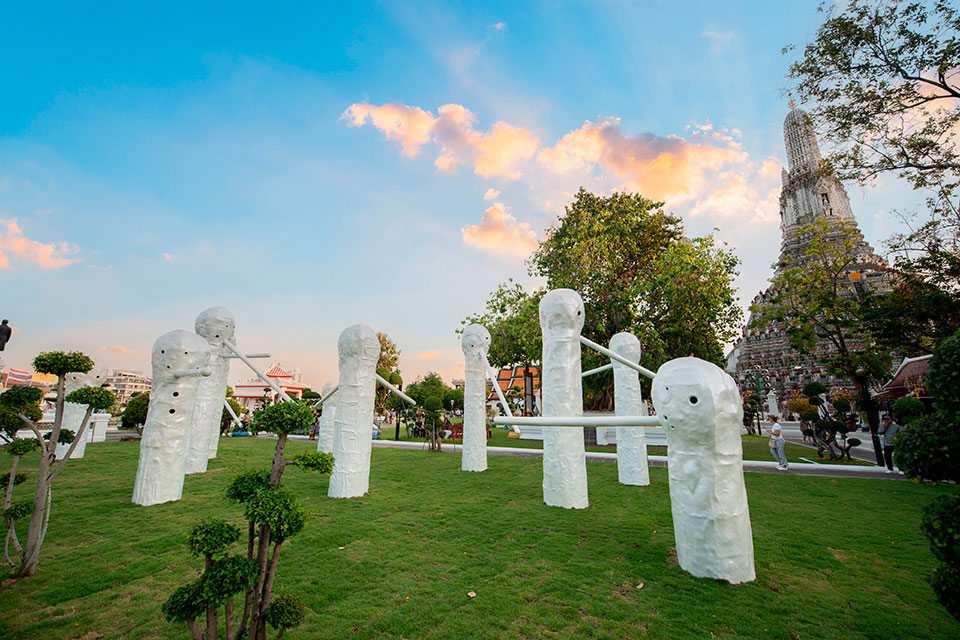
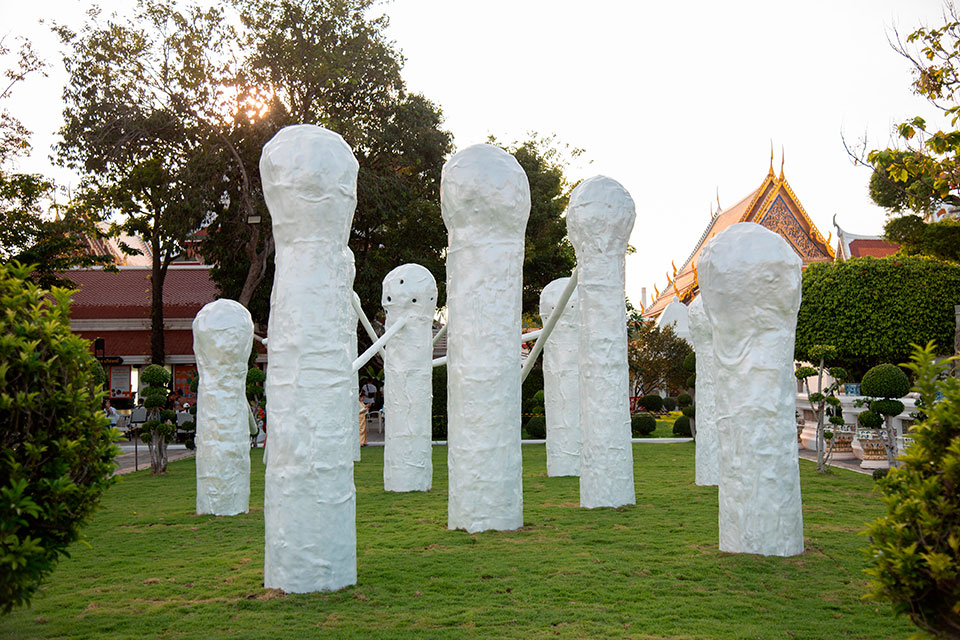
Il Wat Pho o Tempio del Reclining Buddha e il Wat Phra Chetuphon Wimon Mangkhalaram Rajwaramahawihan ospitano le sculture di Louise Bourgeois. L’artista franco-americana rompe il rapporto con la rappresentazione tradizionale e inizia una modalità espressiva che incarna la ricerca sulle energie del profondo. Lei mette l’accento su organi e orifizi sessuali, veicolo fisico di quelle energie4. La voracità del potere trasforma la paura dell’altro in desiderio di intrappolare: e la vittima diviene carnefice5. La scultura in bronzo Nature Study (1984), esposta nel Bangkok Art and Culture Centre (BACC), incarna l’ambiguità delle forze opposte nell’essere: ha l’aspetto incerto tra uomo e bestia, tra maschio e femmina, come una divinità enigmatica, nata dalla ricomposizione di frammenti umani tra una doppia fila di seni, organi maschili e zampe di animale. Sul prato del Miskawan Garden del Wat Pho, accanto al vecchio albero della bodhi (illuminazione), è posizionata l’opera Eyes (1995), composta da due grandi sculture rotonde a distanza calcolata tra loro. Le pupille sporgenti guardano verso le finestre del tempio, verso uno spiraglio per accedere al gigantesco Reclining Buddha. Nel 2007 Louise Bourgeois ha donato la scultura Hold Me Close per il Tsunami Sculpture Memorial Project al Nopparat Tara National Park di Krabi.
Wat Pho or the Temple of the Reclining Buddha and Wat Phra Chetuphon Wimon Mangkhalaram Rajwaramahawihan house sculptures by Louise Bourgeois. The French-American artist breaks the relationship with traditional representation and initiates a mode of expression that embodies research into deep energies. She highlights organs and sexual orifices – the physical vehicle of those energies4. The voracity of power transforms fear of the other into a desire to entrap: and the victim becomes executioner5. The bronze sculpture, Nature Study (1984), exhibited in Bangkok Art and Culture Centre (BACC), embodies the ambiguity of the opposing forces in all beings: it has the uncertain appearance of something between man and beast, between male and female, like an enigmatic deity, born from the recomposition of human fragments among a double row of breasts, male organs and animal legs. On the grass field of Wat Pho’s Miskawan Garden, next to the old Bodhi (enlightenment) tree, stands the work, Eyes (1995), consisting of two large round sculptures set at a calculated distance from each other. The bulging pupils look toward the temple windows, toward a small opening to access the giant Reclining Buddha. In 2007 Louise Bourgeois donated the sculpture, Hold Me Close, to the Tsunami Sculpture Memorial Project at Nopparat Tara National Park in Krabi.
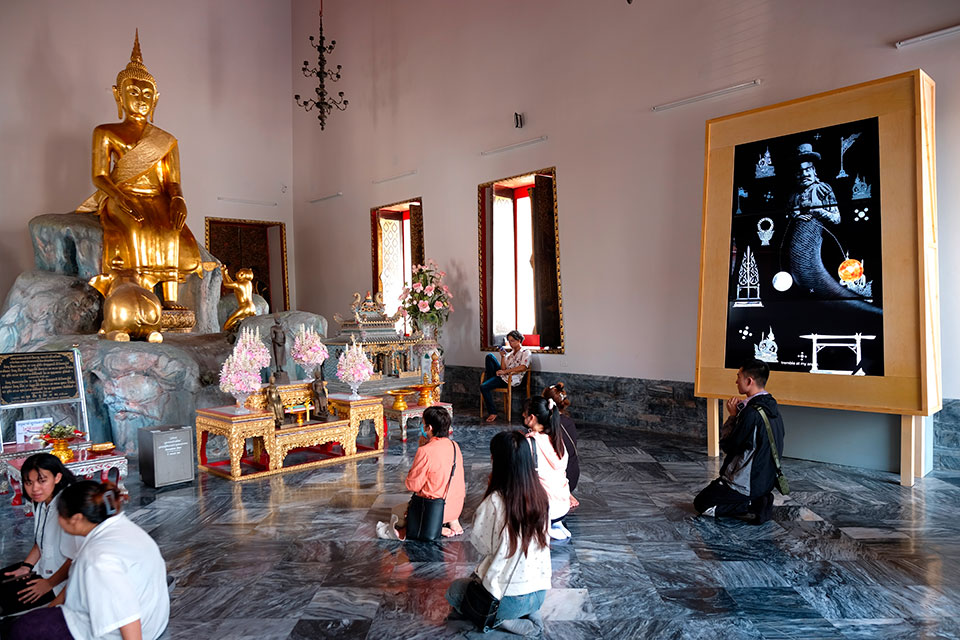
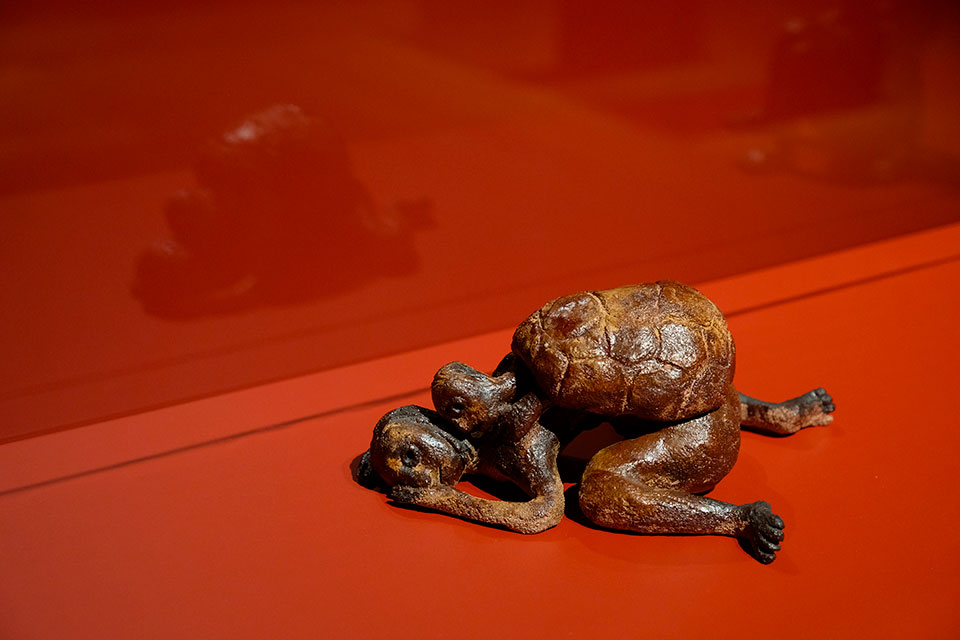
Esposta alla 60^ Mostra d’Arte Internazionale di Venezia, accolta tra gli Eventi Collaterali e transitata nella IV Biennale Nurture Gaia, lungo una rotta tra Venezia e Bangkok, la mostra collettiva The Spirits of Maritime Crossing racconta, attraverso differenti media, storie di paesi colpiti da devastazioni, colonialismi, malattie, guerre6. La partecipazione artistica alle due biennali è un impegno civile e di conoscenza delle tematiche sociali. La filosofia del rispetto per la natura include le forme di vita che abitano la terra, senza distinzione di genere. Gli artisti di The Spirits of Maritime Crossing, legati in un comune progetto affrontano temi di realtà sociale, di colonialismi, di migrazioni in favore di politiche ecologiche, multirazziali, in difesa della crescita percettiva individuale, che è la centralità per la consapevolezza culturale e artistica dell’uomo.
Exhibited at the 60th Venice International Art Exhibition as part of Collateral Events and taken to the fourth Nurture Gaia Biennale along a route between Venice and Bangkok, the group exhibition, The Spirits of Maritime Crossing, tells, through different media, stories of countries affected by devastation, colonialism, disease and war6. Artistic participation in the two biennales is an act of civic engagement and awareness of social issues. The philosophy of respect for nature includes all life forms inhabiting the earth, regardless of gender. Connected by a common project, the artists of The Spirits of Maritime Crossing address issues dealing with social actualities, colonialism and migration in favor of ecological and multiracial policies defending the growth of individual insight, which is at the core of cultural and artistic awareness.
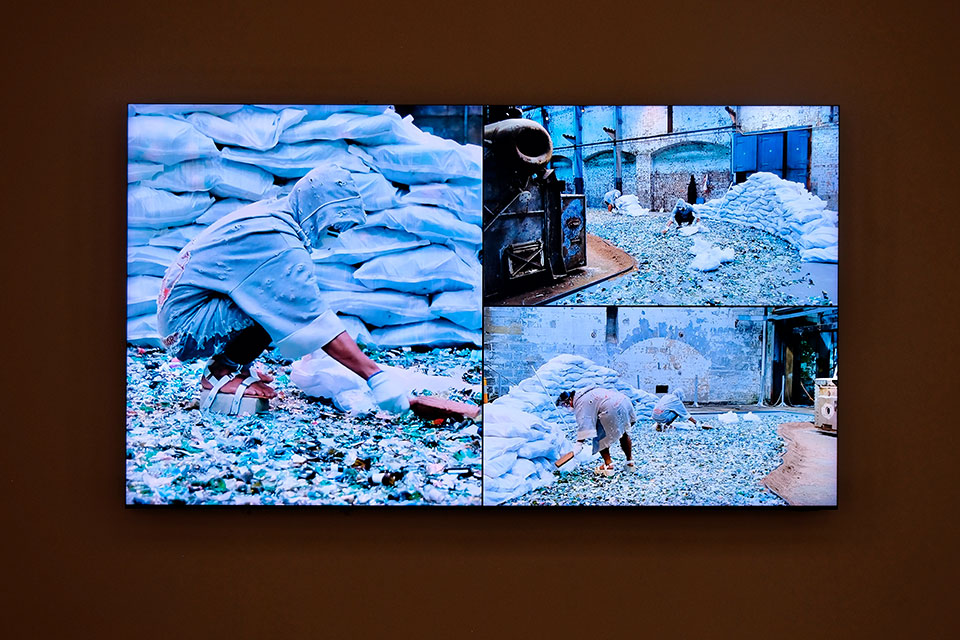
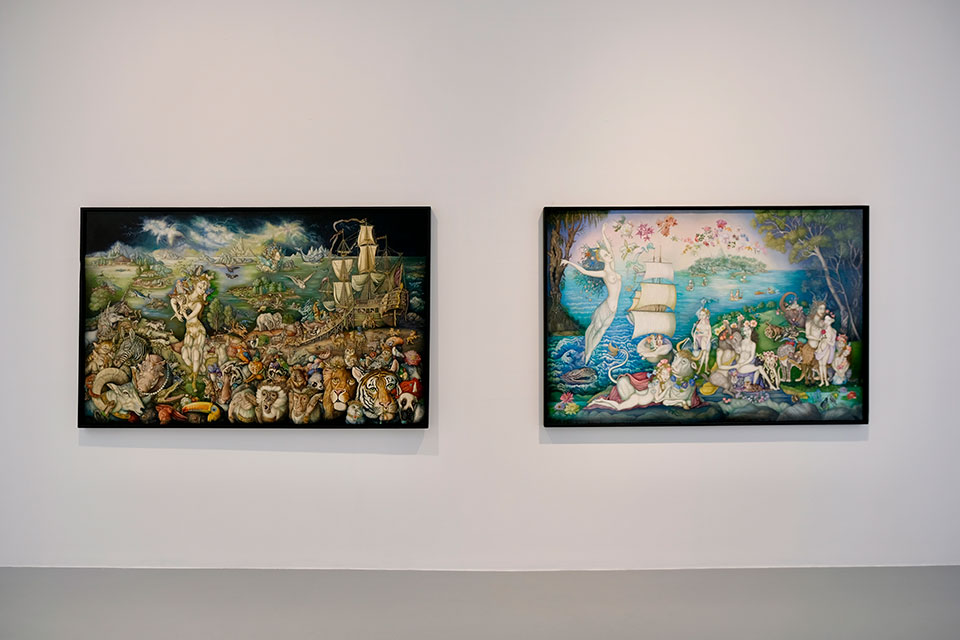
Marina Abramovič and Pichet Klunchun, Chitti Kasemkitvatana and Nakrob Moonmanas, Pihet Klunchun, Jompet Kusuwidananto, Bounpaul Phothyzan, Alwin Reamillo, Khvay Sammang, Natee Utarit, Yee-I-Lann e la comunità del mare Truong Cong Tuang, Jakkai Siributr in collaborazione con i richiedenti asilo Moe Satt, Priyageetha Dia e Kawita Vatanajyankur presentano con immagini le condizioni di vita in alcuni paesi o le sussurrano in lingue diverse. Nel discorso di presentazione della 19. Biennale di Architettura, il presidente Pietrangelo Buttafuoco ha posto l’accento sulle distruzioni e, citando l’articolo del suo maestro Luciano Violante, ha precisato la sistematicità con cui le guerre dalla Birmania a Gaza all’Ucraina, dal Libano alla Siria, ai paesi dell’Africa, stanno distruggendo generazioni di giovani e di vite7. Questa sistematicità consiste nel domicidio (deliberata distruzione della casa) e nel memoricidio (distruzione della memoria e del passato di alcuni popoli), termini coniati dal professore Balakrishnan Rajagopal. Privare i popoli della memoria costruita nella casa, nella città, nelle scuole, negli ospedali, nelle biblioteche vuol dire togliere loro i riferimenti identitari e trasformarli in mandrie8. L’arte sociale recupera frammenti di storia, modelli di vita comune, che sono il materiale, la forza interna per sopravvivere al processo di distruzione.
Marina Abramovič and Pichet Klunchun, Chitti Kasemkitvatana and Nakrob Moonmanas, Jompet Kuswidananto, Bounpaul Phothyzan, Alwin Reamillo, Khvay Samnang, Natee Utarit, Yee I-Lann and the sea community, Truong Cong Tung, Jakkai Siributr in collaboration with asylum seekers, Moe Satt, Priyageetha Dia and Kawita Vatanajyankur present the living conditions in some countries with pictures or whisper them in different languages. In his keynote address at the presentation of the Architecture Biennale 19th, Pietrangelo Buttafuoco, president of the Venice Biennial Foundation, emphasized the destruction caused by wars from Myanmar to Gaza and Ukraine, from Lebanon to Syria and the countries of Africa. He cited his mentor, Luciano Violante, whose has pointed out the systematic approach with which these wars are destroying generations of young people and lives7. This systematic approach consists of domicide (the deliberate destruction of housing), a term coined by the human rights scholar, Balakrishnan Rajagopal, and memoricide (the destruction of memory and the past of certain people). To deprive people of the memory built in their homes, in their city, in schools, in hospitals and in libraries is to take away the points of reference of their identity and to turn them into “lost sheep”8. Social art recovers fragments of history, patterns of everyday life, which are the material, the internal power for surviving the process of destruction.
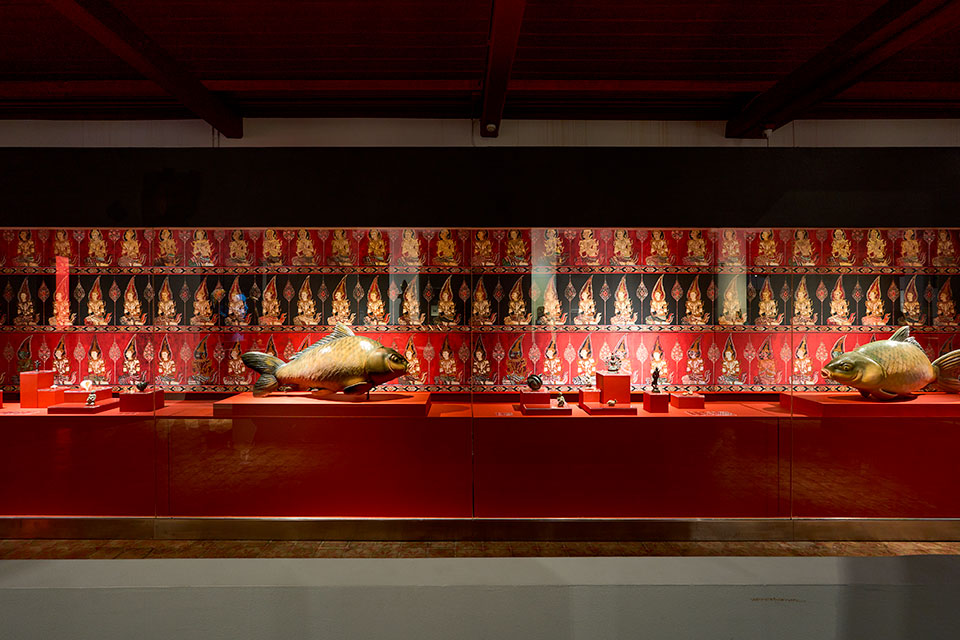
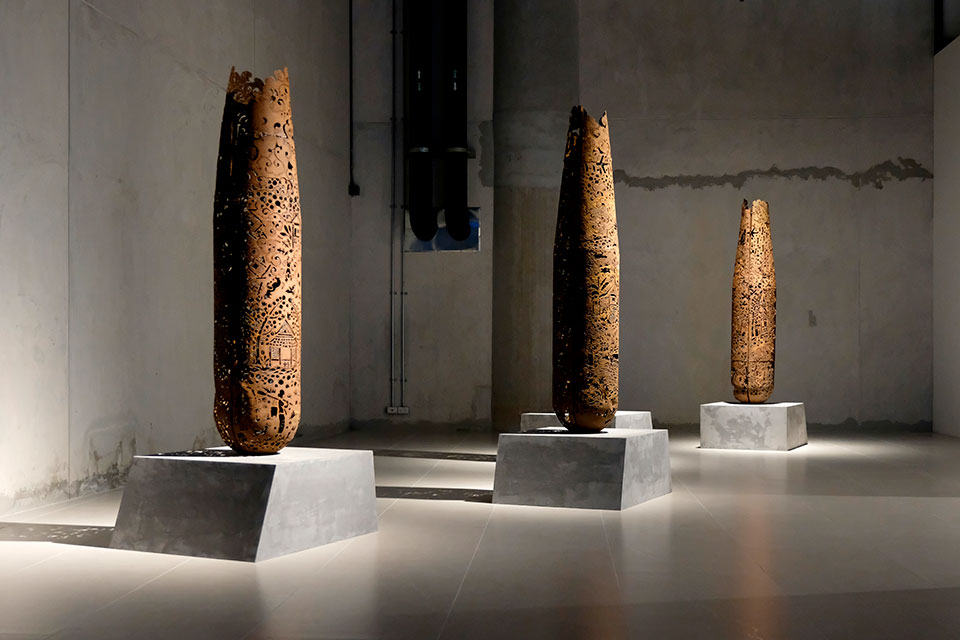
Priyageetha Dia, nel video The Sea is a Blue Memory (2022) presentato nella Biennale di Venezia nella mostra The Spirits of Maritime Crossing, relaziona le correnti marine ai flussi migratori dalla coste dell’India alla penisola malese in una visione di collaborazione. Per la Biennale di Bangkok, con il video Spectre System l’artista affronta la condizione dello sfruttamento coloniale. Il conflitto tra il fenomeno migratorio e la struttura dei territori ha impostato una concezione arida dell’individuo inteso come homo oeconomicus9. Il sonoro dell’opera fa sentire, nello spazio della sala, il respiro di quei lavoratori che hanno attraversato il mare difendendo il sogno e memoria10.
In the video, The Sea is a Blue Memory (2022), presented at the Venice Biennale in the The Spirits of Maritime Crossing exhibition, Priyageetha Dia compares sea currents to migratory flows from the coast of India to the Malay Peninsula in a vision of collaboration. For the Bangkok Biennale, the artist addresses the condition of colonial exploitation with the video, Spectre System. The conflict between the phenomenon of migration and the structure of territories has set up a cold conception of the individual understood as homo economicus9. The sound effects of the piece make one hear in the exhibition space the breath of those workers who crossed the sea defending their dreams and memory10.
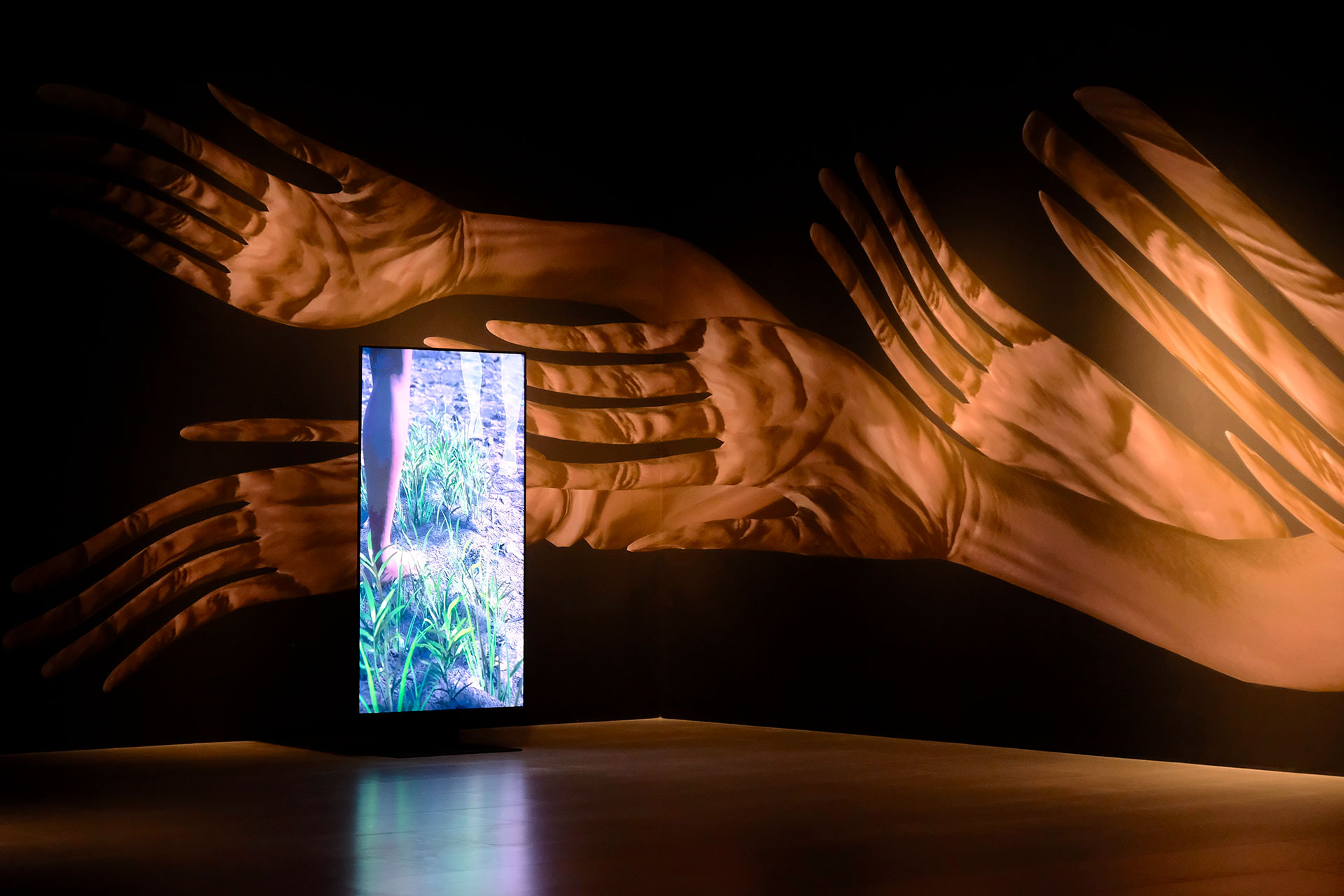
In The Spirits of Maritime Crossing, Marina Abramovič parte da Venezia verso Bangkok alla ricerca di una pace interiore, attraversando terre sconosciute sconvolte da guerre, malattie, sfruttamenti sociali11. Arrivata a Bangkok, dopo aver vagato per la città e i canali, l’artista trova, in un edificio in stile rinascimentale veneziano, il Monkey Master, che le dona una veste bianca. Il danzatore Pichet Kluncun, studioso di danza tradizionale tailandese (Khon) e di danza moderna, interpreta il Re Scimmia e, circondato da sacerdoti e talismani, coniuga nei gesti e nei passi la religiosità orientale e occidentale. In sua compagnia Abramovič inizia un pellegrinaggio tra i luoghi spirituali di Bangkok e nel Wath Po incontra un monaco che le insegna come liberare la sua anima dalle afflizioni. L’artista si accorge di aver conquistato la distanza dal coinvolgimento fisico. Ritornata a Venezia da sotto al ponte dei Sospiri può guardare in lontananza la chiesa di Santa Maria della Salute in Venezia.
Chitti Kasemkitvattana e Nakrob Moonmanas, nell’installazione video Our Place In Their World, proseguono il tema del viaggio, esplorando frammenti artistici del Siam e segmenti di vita del re Chulalongkorn Rama V sulla sua visita diplomatica a Venezia nel 1897. L’opera è parte della mostra allestita nel National Museum, voluto nel 1897 dal sovrano. Gli artisti hanno elaborato una visione delle storia, delle società e dell’uomo come un incontro tra sfere, che divengono porose agli eventi esterni. Lo scambio energetico tra corpi guida il collage, gli accostamenti cromatici, l’incontro tra gli uomini. Il loro lavoro di ricerca in archivi storici, letterari, artistici, documenta segmenti di tessuti socio-culturali della vita comune tailandesi, da cui sono emersi giovani come KSR Kulap, Nai Tong Khum, Boosra Mahin che hanno contribuito ad arricchire la memoria collettiva.
In The Spirits of Maritime Crossing, Marina Abramovič sets out from Venice to Bangkok in search of inner peace, traversing unknown lands wracked by war, disease or social exploitation11. Arriving in Bangkok and wandering the city and canals, the artist finds, in a Venetian Renaissance-style building, the Monkey Master, who gives her a white robe. Dancer Pichet Klunchun, an expert in traditional Thai dance (Khon) and modern dance, plays the Monkey King and, surrounded by priests and talismans, combines Eastern and Western religiosity in his gestures and steps. In his company, Abramovič begins a pilgrimage to the spiritual places of Bangkok, and in Wat Pho she meets a monk who teaches her how to free her soul from affliction. The artist realizes that she has conquered distance from physical involvement. Back in Venice from under the Bridge of Sighs she can gaze into the distance at the city’s church of Santa Maria della Salute.
Chitti Kasemkitvatana and Nakrob Moonmanas, in their video installation, Our Place In Their World, continue the theme of travel, exploring artistic fragments of Siam and parts of King Chulalongkorn’s (Rama V) life on his diplomatic visit to Venice in 1897. The work is part of the exhibition set up in the National Museum, whose construction was commissioned by the ruler in 1897. The artists developed a vision of history, societies and humans as a coming together of spheres, which become porous to external events. The energetic exchange between bodies animates the collage, the color combinations and the meeting of human beings. Their research of historical, literary, and artistic archives documents parts of the socio-cultural fabric of Thai communal life, from which young people, such as K.S.R. Kulap, Nai Tong Khum and Boosra Mahin emerged and contributed to enriching the collective memory.
Con una visione poetica degli anelli che compongono la catena invisibile della vita l’artista Dusadee Huntrakul presenta l’installazione A Verse for Nights, costituita da ceramiche, oggetti, conchiglie, disegni suoi e di suo figlio. L’idea che il mondo è una sola vita è espressa dall’artista italiana Chiara Camoni. Il soggetto invisibile delle sculture Sister (Flame and Foam) è il naturale legame di sangue, che è un aspetto della connessione spaziale e temporale: i legami sono la storicità dell’uomo e delle forme del mondo. È possibile esprimere questo filo in versi poetici, in un pensiero filosofico, nella religione, nell’arte come forma di vita come è stato per molti artisti e per Joseph Beuys. Le opere di Beuys sono realizzate con materiali poveri che immettono nel rapporto diretto tra arte, società, religione. I disegni, esposti al National Museum tra gli oggetti della collezione, perdono la connotazione temporale e sembrano realizzare il desiderio dell’artista: arrivare da un’altra parte seguendo nella sua arte quel qualcosa che va altrove. I manufatti sacri e mitologici nella collezione del museo e i delicati oggetti d’arte di Beuys condividono rispetto e dedizione per le dee della madre terra12.
With a poetic vision of the links that make up the invisible chain of life, artist Dusadee Huntrakul presents the installation, A Verse for Nights, consisting of ceramics, objects, shells, and his and his son’s drawings. The idea that the world is just one life is expressed by Italian artist Chiara Camoni. The invisible subject of the Sister (Flame and Foam) sculptures is the natural bond of blood, which is an aspect of spatial and temporal connection: the bonds are the heritage of humanity and the shapes of the world. It is possible to express this connection in poetic verse, in philosophical thought, in religion, in art as a form of life as it was for many artists and for Joseph Beuys. Beuys’ works are made from humble materials that enter into a direct relationship between art, society and religion. The drawings are exhibited among the objects in the National Museum’s collection where they lose their temporal connotation and seem to fulfill artist desire: go somewhere else by following that something in his art that goes elsewhere. The sacred and mythological artifacts in the museum’s collection and Beuys’ delicate art objects share a respect for and dedication to the goddesses of Mother Earth12.
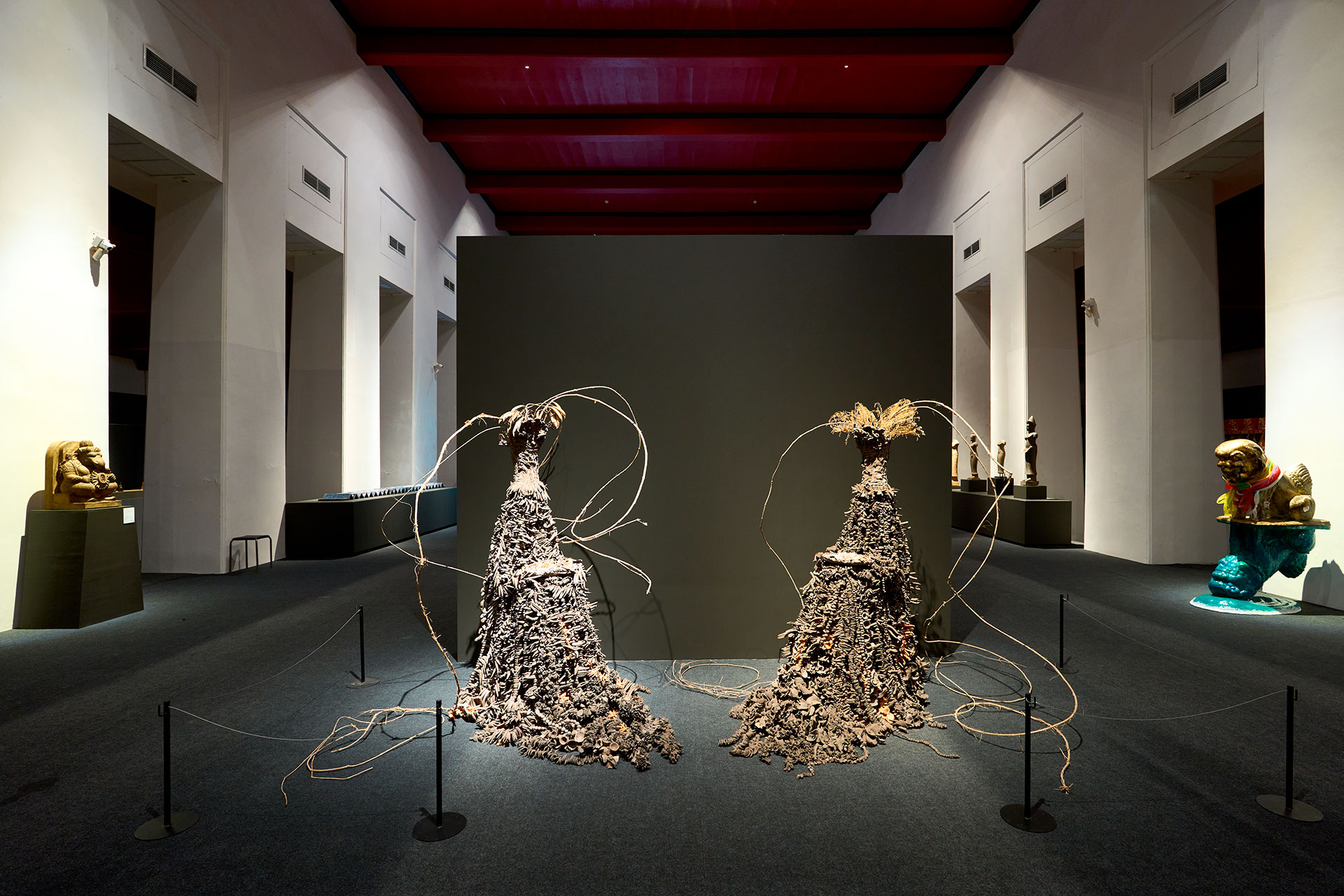
Beuys e Bourgeois sono artisti ribelli a totalitarismi sociali, politici, convenzionali, consumistici e a tutto ciò che limita lo sviluppo del soggetto e della sua esperienza.
L’artista Sud coreano Choi Jeong Hwa sviluppa il tema sul rispetto della natura con un’opera condivisa con il pubblico invitato a portare contenitori in plastica che insieme trasformeranno in creazioni artistiche. Con progetto You Are My Sunshine l’artista desidera educare, incoraggiare la comprensione del rapporto tra uomo, natura e plastica. Nel Bangkok Art & Culture Centre, Choi Jeong Hwa espone sculture in plastica di grandi dimensione, gonfiabili che sfoggiano colori lucenti. Dal luminoso soffitto del Bangkok Art and Culture Centre scende la scultura Golden Girl: sembra una madre o un angelo d’oro. Nella creatività dell’artista coreano la plastica diviene materiale prezioso, scintillante, come vetro colorato: una struttura interna anima l’opera, la rende danzante.
Le opere esposte maritano attenzione e sollecitano riflessioni sulla diversità delle biennali e sulle differenti visioni delle problematiche sociali. Natura Gaia è un invito a guardare dall’interno la natura e accorgerci che siamo tutti una sola vita13.
Beuys and Bourgeois are artists rebelling against social, political, conventional and consumerist totalitarianism and anything else that limits the development of the subject and his or her experience.
South Korean artist Choi Jeong Hwa develops the theme of respecting nature with a work shared with the public who is invited to bring plastic containers that will make artistic creations. With the project, You Are My Sunshine, the artist wishes to educate and to encourage an understanding of the relationship between humans, nature and plastic. In the Bangkok Art and Culture Centre, Choi Jeong Hwa exhibits large plastic sculptures – inflatables that sport bright colors. From the culture center’s bright ceiling descends the sculpture, Golden Girl: she looks like a mother or a golden angel. Thanks to the Korean artist’s creativity, plastic becomes a precious, glittering material, like colored glass: an internal structure animates the work, makes it dance.
The exhibited works merit attention and inspire reflection on the diversity of biennales and different views on social issues. Nuture Gaia is an invitation to look from within nature and realize that we are all one life13.
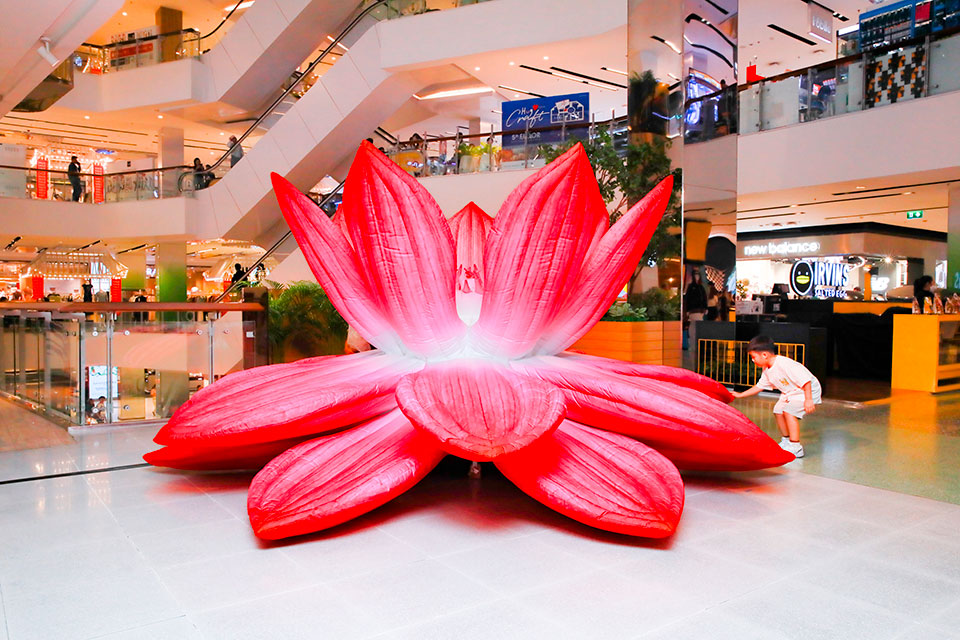
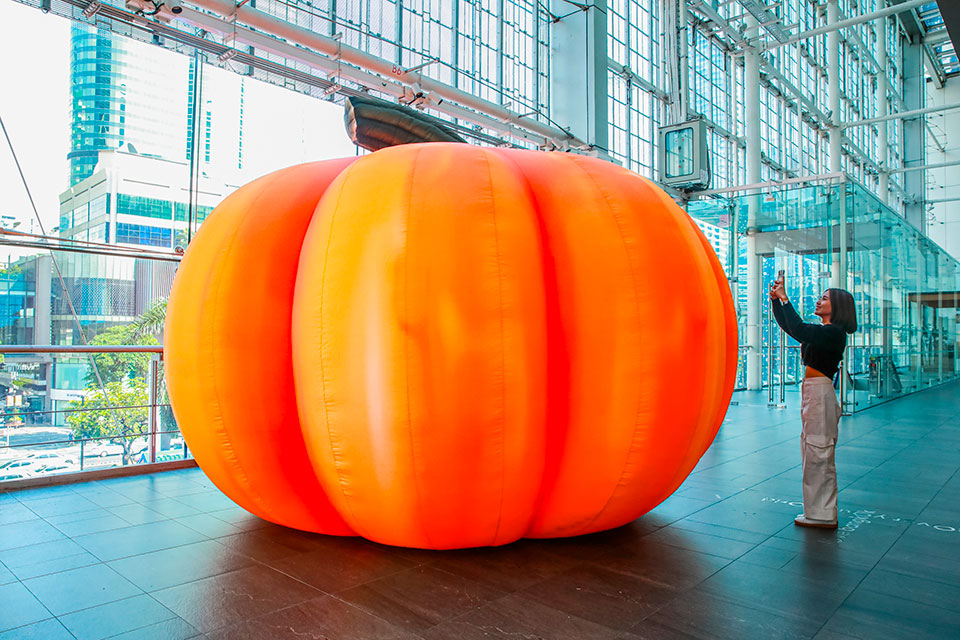
1 Adel Abdessemed, Busui Ajaw, Adel Akarapat, Agnes Arellano, Bruce Asbestos, Aideen Barry, Adel Akarapat, Joseph Beuys, George Bolster, Louise Bourgeois, Jennie Bringaker, Lêna Bùi, Dante Buu, Chiara Camoni, Kanya Charoensupkul, Choi Jeong Hwa, Isaac Chong Wai, Viriya Chotpanyavisut, Daniela Comani, Amanda Coogan, Tony Cragg, Rob Crosse, Priyageetha Dia, Guerreiro do Divino Amor, Nick Dudka, Michael Elmgreen, Lello Esposito, Chitra Ganesh, Gimhongsok, Agi Haines, Amanda Heng, Camille Henrot, Dusadee Huntrakul, Aki Inomata, Mella Jaarsma, George K, Anish Kapoor, Chitti Kasemkitvatana, Yanawit Kunchaethong, Cole Lu, Prasong Luemuang, Maria Madeira, Zul Mahmod, Nakrob Moonmanas, Sophirat Muangkum, Kira O’Reilly, Bagus Pandega & Kei Imazu, Mutmee Pimdao Panichsamai, H.S.H. Princess Marsi Sukhumbhand Paribatra, Pejvak Collective, Bounpaul Phothyzan, Abraham Poincheval, Ravinder Reddy, Lisa Reihana, Taiki Sakpisit, Moe Satt, Thavika Savangwongsakul, Nuttapon Sawasdee, Jessica Segall, David Shongo & Flip Van Dingenen, Pim Sudhikam, Som Supaparinya, Young-jun Tak, Latai Taumoepeau, Komkrit Tepthian, Tian Xiaolei, Aleksandar Timotic, Jasmine Togo-Brisby, Deneth Piumakshi Veda Arachchige, Xiyao Wang, Supawich Weesapen, WISHULADA, Pokchat Worasub, Mai Yamashita + Naoto Kobayashi
2 Cfr. Pseudo-Longino, Del Sublime, Rizzoli Editore, Milano, 1991, pag. 107
Il trattato è una monografia anonima del I secolo d. C. attribuita a Dionysii Longini Rhetoris, identificato in Cassio Longino, critico omerico e filosofo platonico. Cassio Longino fu il filosofo ministro di Zenobia, regina di Palmira.
3 Emanuele Coccia, La vita delle piante. Metafisica della mescolanza, Il Mulino, Bologna, 2019
4 Cfr. Yves-Alain Bois, Rosalind Krauss, L’informe, Bruno Mondadori Editore, Milano, pag. 239
5 Cfr. Hall Foster, Rosalind Krauss, Yves Alain Bois, Arte dal ‘900, Zanichelli, Milano, pag. 501
6 Apinan Poshyananda, Bangkok Art Biennale, Nurture Gaia, First published 2024 by Bangkok Art Biennal Foundacion, pag. 79
7 Pietrangelo Buttafuoco, presidente della Fondazione Biennale Venezia, tratto dalla presentazione della 19. Mostra Internazionale di Architettura, Intelligens, Naturale. Artificiale. Collettiva, a cura di Carlo Ratti, 11 febbraio 2025, Ca’ Giustinian, Venezia
8Cfr. Luciano Violante, Siamo ormai nell’epoca del domicidio, Corriere della sera, 18 gennaio, 2025, in introduzione di Luciano Violante al convegno Condizione umana. Luoghi di libertà nell’era digitale svoltosi in Parlamento il 20 gennaio 2025.
9 Cfr. Franco Ferrarotti, La sociologia alla riscoperta della qualità, Laterza, Bari, 1989, pag. 84
10 Cfr. Gaston Bachelard, Psicanalisi delle acque, Red Edizioni, Como, 1992, pag. 16
11 The Spirits of Maritime Crossing (2022), scritto e diretto da Apinan Poshyananda, commissionato da Bangkok Art Biennale Foundation.
12 Cfr. Bangkok Art, Nurture Gaia, bkkartbiennale.com, Bangkok 2024, pag. 075
13 Cfr. E. Coccia, Metamorfosi. Siamo un’unica, sola vita, Einaudi, Torino, 2022
1 Adel Abdessemed, Busui Ajaw, Adel Akarapat, Agnes Arellano, Bruce Asbestos, Aideen Barry, Adel Akarapat, Joseph Beuys, George Bolster, Louise Bourgeois, Jennie Bringaker, Lêna Bùi, Dante Buu, Chiara Camoni, Kanya Charoensupkul, Choi Jeong Hwa, Isaac Chong Wai, Viriya Chotpanyavisut, Daniela Comani, Amanda Coogan, Tony Cragg, Rob Crosse, Priyageetha Dia, Guerreiro do Divino Amor, Nick Dudka, Michael Elmgreen, Lello Esposito, Chitra Ganesh, Gimhongsok, Agi Haines, Amanda Heng, Camille Henrot, Dusadee Huntrakul, Aki Inomata, Mella Jaarsma, George K, Anish Kapoor, Chitti Kasemkitvatana, Yanawit Kunchaethong, Cole Lu, Prasong Luemuang, Maria Madeira, Zul Mahmod, Nakrob Moonmanas, Sophirat Muangkum, Kira O’Reilly, Bagus Pandega & Kei Imazu, Mutmee Pimdao Panichsamai, H.S.H. Princess Marsi Sukhumbhand Paribatra, Pejvak Collective, Bounpaul Phothyzan, Abraham Poincheval, Ravinder Reddy, Lisa Reihana, Taiki Sakpisit, Moe Satt, Thavika Savangwongsakul, Nuttapon Sawasdee, Jessica Segall, David Shongo & Flip Van Dingenen, Pim Sudhikam, Som Supaparinya, Young-jun Tak, Latai Taumoepeau, Komkrit Tepthian, Tian Xiaolei, Aleksandar Timotic, Jasmine Togo-Brisby, Deneth Piumakshi Veda Arachchige, Xiyao Wang, Supawich Weesapen, WISHULADA, Pokchat Worasub, Mai Yamashita + Naoto Kobayashi
2 Cf. Pseudo-Longino, Del Sublime (On the Sublime), Rizzoli Editore, Milano, 1991, p. 107
The work is an anonymous monograph from the 1st century A.D. attributed to Dionysii Longini Rhetoris, identified as Cassius Longinus, Homeric critic and Platonic philosopher. Cassius Longinus was the philosopher-minister to Zenobia, queen of Palmyra.
3 Emanuele Coccia, La vita delle piante. Metafisica della mescolanza (The Life of Plants. A Metaphysics of Mixture), Il Mulino, Bologna, 2019
4 Cf. Yves-Alain Bois, Rosalind Krauss, L’informe (Formlessness), Bruno Mondadori Editore, Milano, p. 239
5 Cf. Hall Foster, Rosalind Krauss, Yves Alain Bois, Arte dal ‘900 (Art from 1900), Zanichelli, Milano, p. 501
6 Apinan Poshyananda, Bangkok Art Biennale, Nurture Gaia, First published 2024 by Bangkok Art Biennal Foundacion, p. 79
7 Pietrangelo Buttafuoco, President of the Venice Biennial Foundation, an excerpt from the presentation of 19. Mostra Internazionale di Architettura, Intelligens, Natural. Artificial. Collective, curator Carlo Ratti, February 11, 2025, Ca’ Giustinian, Venezia
8 Cf. Luciano Violante, Siamo ormai nell’epoca del domicidio (We are already in the era of domicide), Corriere della sera (newspaper), January 18, 2025. An excerpt from the introduction of Luciano Violante at the conference, Condizione umana. Luoghi di libertà nell’era digitale (The Human Condition. Places of Freedom in the Digital Age) held in the Italian Parliament Jan. 20, 2025.
9 Cf. Franco Ferrarotti, La sociologia alla riscoperta della qualità (Sociology looking to rediscover quality), Laterza, Bari, 1989, p. 84
10 Cf. Gaston Bachelard, Psicanalisi delle acque (Psychoanalysis of the waters), Red Edizioni, Como, 1992, p. 16
11 The Spirits of Maritime Crossing (2022), written and directed by Apinan Poshyananda, commissioned by the Bangkok Art Biennial Foundation.
12 Cf. Bangkok Art, Nurture Gaia, bkkartbiennale.com, Bangkok 2024, p. 075
13 Cf. E. Coccia, Metamorfosi. Siamo un’unica, sola vita (Metamorphoses), Einaudi, Torino, 2022
